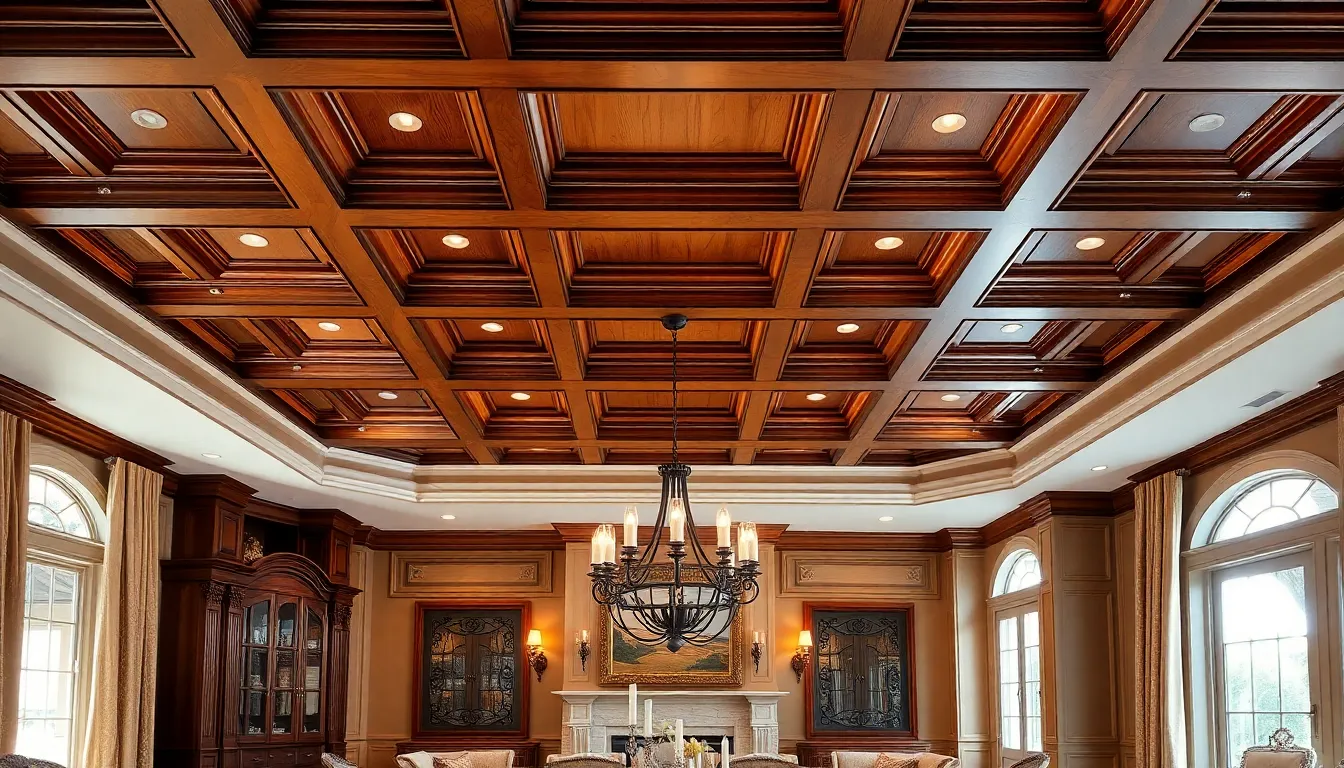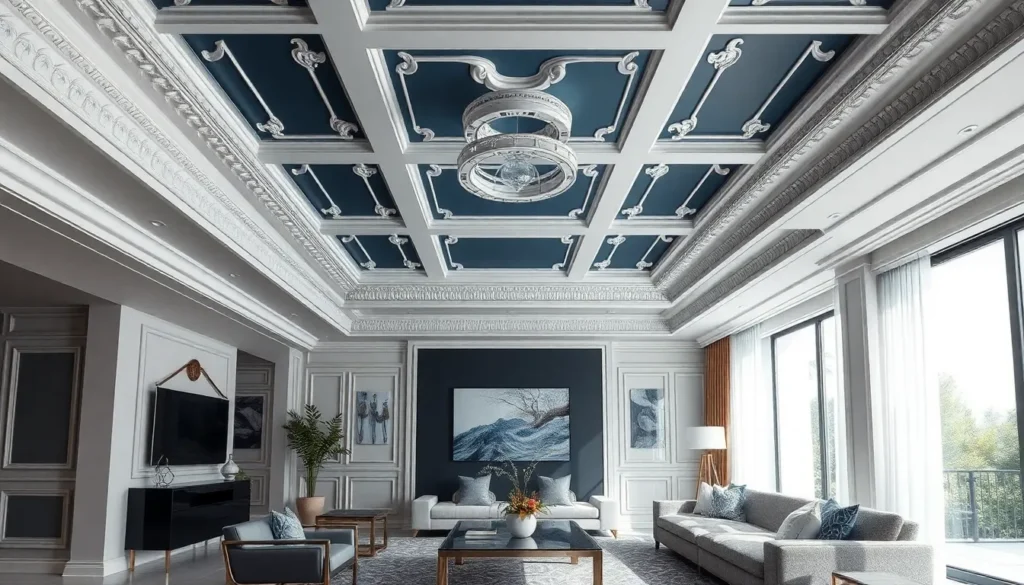Table of Contents
ToggleWhen it comes to home design, ceilings often get the short end of the stick. They’re like the overlooked middle child—often ignored but full of potential. If walls could talk, they’d probably complain about their ceilings being boring. But fear not! It’s time to elevate your space and give those overhead expanses the attention they deserve.
Modern Ceiling Design Ideas
Ceiling designs can transform a space and enhance overall aesthetics. Here are some modern approaches.
Minimalist Approaches
Minimalist ceiling designs prioritize clean lines and simplicity. White ceilings with subtle textures create a spacious feel. Using recessed lighting provides both ambiance and functionality while keeping visual clutter to a minimum. Flat ceilings paired with large windows allow natural light to fill rooms, enhancing the airy atmosphere. Adding wooden beams or panels in a light finish can introduce warmth, aligning with minimalist principles.
Statement Ceilings
Statement ceilings attract attention and make bold impressions. Installing intricate moldings or decorative plaster adds elegance. High-contrast colors, such as dark grays or rich blues, can create a striking focal point. Using geometric patterns or artistic murals turns ceilings into unique canvases. Incorporating lighting fixtures that hang elegantly from the ceiling further amplifies the design, drawing the eye upward and creating depth within the space.
Traditional Ceiling Design Ideas

Traditional ceiling designs offer timeless elegance while adding architectural interest. Two popular types include coffered ceilings and tray ceilings.
Coffered Ceilings
Coffered ceilings feature a grid pattern created by recessed panels. This classic design adds depth and dimension to any room. Often, wood beams or plaster moldings highlight the panels. Many homeowners appreciate the sophisticated look these ceilings provide. Spaces such as dining rooms or studies often benefit from coffered ceilings, enhancing the overall atmosphere with a luxurious touch.
Tray Ceilings
Tray ceilings showcase an elegant, recessed design that creates a visual appeal. Generally, the center section sits above the surrounding ceiling, drawing attention to the height of the room. This style allows for the addition of lighting, making it perfect for dramatic effects. Common in bedrooms and living areas, tray ceilings bring warmth and character. Homeowners can customize colors and finishes, ultimately enhancing their unique design aesthetic.
Creative Ceiling Design Ideas
Ceilings can serve as an artistic canvas, providing opportunities for creative expression. Exploring painted and textured ceiling options can elevate the overall aesthetic of a room.
Painted Ceilings
Choosing unique colors for ceilings transforms the mood of a space. Pale blues and soft greens create a serene atmosphere, while bold reds or deep blues add drama. Patterns such as stripes or clouds can introduce whimsical elements. Stencils also provide an option for intricate designs, offering personalization tailored to individual tastes. Accent colors complement existing decor, enhancing cohesiveness in the room. High ceilings allow for greater creativity, inviting experimentations that may span the entire area. Implementing these painted designs can yield stunning results that redefine a room’s character.
Textured Ceilings
Opting for textured ceilings introduces depth and dimension, fostering a dynamic visual impact. Techniques like stucco, beadboard, or wood paneling create engaging surfaces. Smooth finishes, like satin or glossy sheens, contrast beautifully against rough textures, adding complexity. Incorporating decorative plaster can evoke historical charm, while wood beams create a rustic feel. Each texture brings forth its own unique vibe, prompting lively conversations and admiration. Textured ceilings enhance light reflection, casting captivating shadows throughout the space. Utilizing these approaches can truly redefine the ambiance and style of any environment.
Sustainable Ceiling Design Ideas
Sustainable ceiling design focuses on environmental responsibility and energy efficiency. Incorporating innovative solutions makes spaces both stylish and eco-friendly.
Eco-Friendly Materials
Natural materials present excellent options for sustainable ceilings. Bamboo offers strength and rapid regrowth, while recycled wood features a unique aesthetic. Cork, known for its thermal insulation, adds warmth and reduces sound transmission. Sustainable ceiling tiles, made from natural fibers, provide an opportunity for creative installations. These choices enhance design while lowering the carbon footprint. Opting for non-toxic paints and finishes ensures better indoor air quality.
Energy-Efficient Designs
Energy-efficient ceiling designs contribute to reduced energy consumption. Implementing recessed lighting minimizes energy use while providing focused illumination. Skylights enhance natural light, reducing the need for artificial lighting during the day. Adding insulation in ceiling spaces regulates temperature, improving HVAC efficiency. Smart ceiling fans circulate air, maintaining comfort without excessive energy costs. Using solar panels integrated into ceilings offers a renewable energy source, boosting sustainability further. These strategies create an inviting environment while emphasizing environmental responsibility.
Ceilings hold untapped potential that can transform any space into a captivating environment. By embracing various design styles—from minimalist to bold statement options—homeowners can elevate their interiors significantly. Traditional designs like coffered and tray ceilings add timeless charm while creative approaches like painted and textured ceilings offer unique expressions of personal style.
Sustainability also plays a crucial role in modern ceiling design. Eco-friendly materials and energy-efficient solutions not only enhance aesthetics but also promote responsible living. With thoughtful consideration of ceiling design, individuals can create inviting spaces that reflect their personality and values, proving that even the overlooked areas can make a substantial impact on home design.




